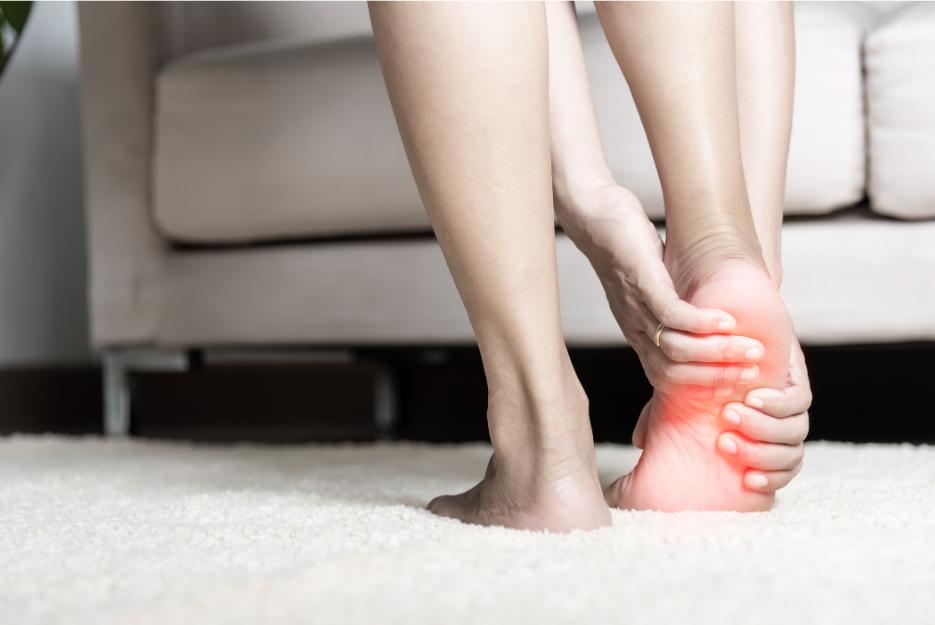Impingement Symptoms & Causes
Background
If you’re experiencing discomfort in a joint of your lower limbs, such as the ankle, or between two bones, particularly when performing movements like pointing your foot up or down, impingement could be a contributing factor.
In podiatry, impingement refers to the restriction or compression of a structure or tissue in the lower limbs. This increased pressure on the affected area can lead to pain or discomfort, especially with certain movements.

Table of Contents
Causes For An Impingement
Symptoms Of An Impingement
The symptoms you experience will largely depend on the structure that has been affected. If a muscle or tendon is involved, you may notice pain, tenderness, and swelling. As the swelling progresses, movement in the area can become restricted and painful, which may make walking difficult, depending on the location of the injury.
If a nerve is compressed, you’re more likely to experience nerve-related symptoms such as burning, numbness, tingling, pins and needles, or pain and tenderness. In some cases, multiple structures may be affected simultaneously, leading to a combination of these symptoms.
Visit Us Today
Hope Island
Phone: 07 5510 9222
Located within Hope Island Marketplace Medical & Skin Clinic, 99-103 Broadwater Ave Hope Island QLD 4212
Jimboomba
Phone: 07 5546 9766
Located Within Jimboomba Medical Centre, Unit 1/69 Cerina Cct, Jimboomba QLD 4280
Beenleigh
Phone: 07 3287 2224
Located Within Beenleigh Mall Medical Centre, Shop24A, 40/68 Main Street, Beenleigh QLD 4207
Eagleby
Phone: 07 2889 1666
Located Within Eagleby Family Practice, 5/120 River Hills Rd, Eagleby QLD 4207
Harristown
Phone: 07 4635 6111
Located Within Toowoomba Medical Centre, 146 Drayton Road, Harristown QLD 4350
Marsden
Phone: 07 3067 2370
Located Within Marsden Family Doctors, Shop 28/55-77 Chambers Flat Rd, Marsden QLD 4132
Keperra
Phone: 07 3355 4082
Located Within Keperra Medical Clinic, 14 Dallas Parade Keperra QLD 4054
Coomera
Phone: 07 5573 5663
Located Within Doctors @ Coomera Central, Shop 6, 21 Coomera Grand Drive, Upper Coomera, QLD 4209
Newtown
Phone: 07 4633 8700
Located Within Ochre Medical Centre Wyalla, Shop 20, 238 Taylor Street, Newtown QLD 4350
Common Impingements In The Lower Limbs
- Anterior ankle impingement: Involves stress on the structures at the front of the ankle, such as the articular cartilage.
- Posterior ankle impingement (Os Trigonum Syndrome): A condition affecting the back of the ankle, often involving an extra bone (Os Trigonum).
- Tarsal tunnel syndrome: Compression of the tibial nerve within the tarsal tunnel, causing nerve-related symptoms.
- Medial ankle impingement: Involves structures on the inner side of the ankle being compressed or irritated.
- Lateral ankle impingement: Compression of tissues on the outer side of the ankle.
- Peroneal nerve impingement: Occurs at the back of the knee, often leading to nerve-related symptoms.
- Interdigital nerve impingement: Compression between the metatarsal heads, which can progress to Morton’s neuroma with swelling and irritation.
- Accessory bone impingement: Compression of extra bones around the foot.
- Impingement of unexpected structures: Includes soft tissue abnormalities like ganglion cysts.
Lower Limb Impingements Treatment
Because impingements can present with symptoms similar to tendinopathies, arthritis, fractures, and other conditions, obtaining an accurate diagnosis from your podiatrist is the crucial first step for effective treatment and management.
Once diagnosed, the primary focus is on alleviating pain and reducing compression or pressure on the affected structures, especially when swelling is involved. This may include custom foot orthotics, braces, splints, footwear adjustments, padding, strapping, or other supportive measures. Swelling can be managed with strategies such as ice application, elevation, compression, rest, off-loading, and non-steroidal anti-inflammatory drugs (NSAIDs). Since symptoms and causes can vary significantly, it’s essential to have a tailored treatment plan developed by your podiatrist to achieve optimal results efficiently.
A long-term approach is also necessary to prevent the recurrence of pain and injury. If your impingement is caused by repetitive activities, like sports, continuing without adjustments may lead to the problem returning. At Priority Podiatry Clinic, we aim to help you remain pain-free and enjoy your favourite activities without discomfort. Your podiatrist will discuss personalised long-term strategies based on your diagnosis, symptoms, lifestyle, and medical history to help you maintain lasting relief.
Enquire Now
Not The Condition You Are Looking For?
Find out more about the conditions we treat by clicking below.
